Ruin Porn

“At the end of the 2007 school year, Jane Cooper Elementary (built in 1920) was left unsecured in the middle of the wasteland where a middle-class neighborhood once stood. It took “scrappers” only a few months to strip the building of every last ounce of metal and leave it looking as though it hadn’t been occupied for decades.” Ruin Porn Philosopher James Griffieon, quoted in the on-line Vice magazine.
I will be up there to take my own pictures in a few weeks, or not. The image above pretty much sums up the concept of what the fashionable are calling “Ruin Porn.” It is a new sort of forbidden pleasure, viewing the abasement of a once mighty city with a certain almost erotic pleasure.
Schadenfreude might be the best way to sum it up: pleasure derived from the misfortunes of others
Philip Levine’s famous poem, “What Work Is,” comes to mind. My pal bonds sent it out as a reminder, in its entirety, but it starts like this in stark reality:
“We stand in the rain in a long line
waiting at Ford Highland Park. For work.
You know what work is–if you’re
old enough to read this you know what
work is, although you may not do it.
Forget you. This is about waiting,
shifting from one foot to another.
Feeling the light rain falling like mist
into your hair, blurring your vision
until you think you see your own brother
ahead of you, maybe ten places.”
It is a powerful poem about a gone world. The Ford Highland Park Assembly Plant was designed by the legendary Detroit architect Albert Kahn, whose graceful factory designs defined the might of the city.
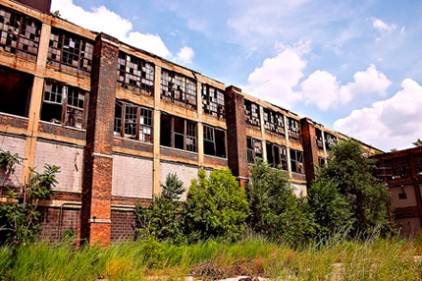
(Ruin porn view of Albert Khan’s Packard Plant, which featured lots of glass and integrated concrete structure.)
Kahn began his career in 1907, when he was commissioned to design a new plant for the upscale Packard Motor Company. Henry Ford liked the concept, and commissioned an improved model for a site in Highland Park, a civic enclave surrounded by Detroit just off Woodward south of McNichols. Ford moved from his original plant at 411 Piquette Street to the Park, and changed the world.
Ruin Porn folks like to show the Model T plant like this:

But like all the porn shots you have to crop the photos carefully to make sure you don’t tell the wrong story. Here is the new CVS strip mall that has been added to the vantage:
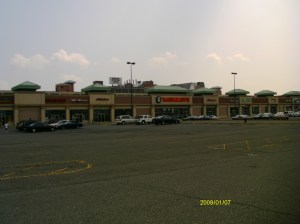
(New CVS Strip Mall in “Model T Square.” 2010)
When the Highland Park factory became too small, Kahn designed new Ford plants just south of Detroit — the River Rouge Complex, which opened in 1927 and held 90,000 workers. It was the biggest industrial plant in the world at the time. Driving I-75 out of the City, as I have hundreds of times, the vast complex never ceases to amaze me, and it was still there the last time I looked.
Kahn was not restricted to industrial work, and his designs were ubiquitous around the area. The SS Kresge World Headquarters downtown was a splendid example. It was the home of Detroit Institute of Technology when I used to visit, but he did hundreds of residential and office buildings around town.
Sad, really, to see then cast aside. Kresge moved out to Troy, and then it got it’s lunch eaten by the monster that is WalMart. I don’t think the new building is abandoned; they don’t do things like that in the City of Tomorrow, Today!
The blight of the crack wars of the 1980s drove most of the rest of the town into ruin. The City became a cartoon hallucinogenic landscape in Robocop, the iconic Peter Weller film set in “In a dystrophic & crime ridden Detroit, a terminally wounded cop returns to the force as a powerful cyborg with submerged memories haunting him.”
I think most diaspora Detroiters took a certain grim pride in things being that bad, and the film, with the exception of some exterior shots, was actually shot in Texas someplace.
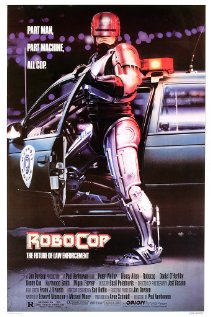
The flight from the city included even those who cannot walk. Families who fled Detroit for the suburbs in the 60s and 70s did not want to return to visit their dead. An active industry in disinterring the dead has sprung up in Elmwood and Mt. Olivette cemeteries and relocating the dearly departed to suburban graves. According to the wondering story on the AP, more than a 1,000 bodies have been exhumed and moved since 2002.
All that said, and goodness knows there is a lot more to say, there is energy in the old burg yet. The industry that so effectively mines derelict structures for scrap metal is one of astonishing vigor. The Jane Cooper Elementary School that sits in the midst of one of Detroit’s urban prairies is a case in point. Abandoned by the School Board only in 2007, the place was stripped of all recyclable material in months.
Still, the photographer who captured the image said he had to be careful to crop the frame. In the midst of the seeming endless expanse of waste, there is a modern and functioning factory to the left of the frame, and a strip mall with activity to the right.
After suffering through decades of racial violence, industrial collapse, serial arson, crack wars, and years of municipal kleptocracy, Detroit is now the destination of choice for Ruin Porn. I am guilty as any in having a grim fascination for the image and metaphor of decay, but it simmers with resentment toward what was done to an old friend. I don’t share the same motivation as, say, the Germans and Japanese who seem to delight in the downfall of the city that armed their one-time tormentor.
So, I was going to organize a “fabulous ruins” tour when we go to the conference in the Motor City in a few weeks. I still will, but there is more nuance to all this. Dave Bing the great former Pistons basketball player is the mayor now, and there is no reason for him to have to grift the city for spare change.
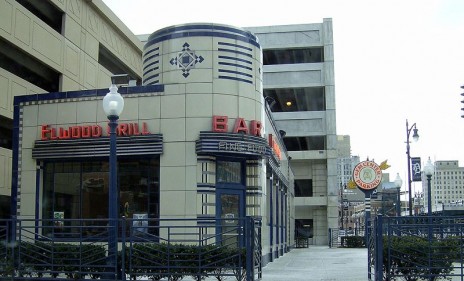
The Greektown casinos and the famed Elwood Grill are still going strong. The Fox Theater glitters with restored Art Deco elegance. I am not saying that the city is coming back, but it is not the story you get from the ruin pornographers. I mean, there is another way to look at it.
Here is the interior of the Ballroom of the famed Book-Cadillac Hotel in porn:
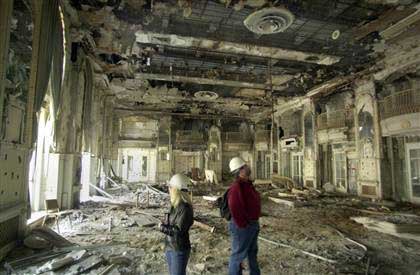
Looks pretty post-apocalypse, right?
Well, here it is the way it looks right now:
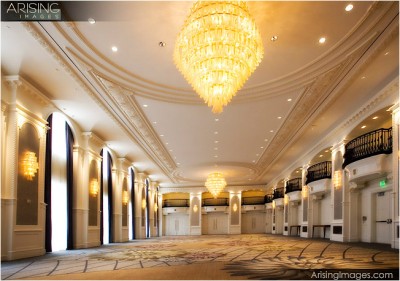
(Photo courtesy Westin Book-Cadillac, 2010.)
The Westin people put their money where their mouths are and they fixed it. So, who knows. Where there is life, there could be hope.
Even those boneheads we elected to Congress figured something out and alternative with an hour to go before they locked themselves out of Capitol.
Copyright 2011 Vic Socotra
www.vicsocotra.com
